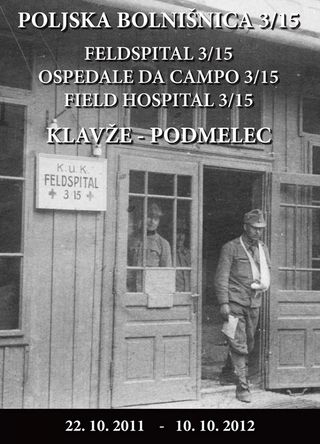Field hospital 3/15 Klavže - Podmelec
22.10.2011 - 10.10.2012The command of the Austro-Hungarian Army began to shift its troops to the area along the Italian border in the second half of May 1915, just before the Italian attack. The first troops of the XV Army Corps reached the Upper Soča Region as late as the day when Italy declared war. In the expectation of fierce fights also the medical service was faced with a very difficult task.
Believing that the defence in the mountains above the Soča would stop Italian attacks, the command decided to arrange a big field hospital in the direct vicinity of the Tolmin bridgehead. Thus good conditions for the forthcoming demanding work would be provided for the medical staff instead of improvised rooms and tents. There were no bigger buildings available in the nearby villages and settlements; however, the sole, and also excellent, solution was offered by the new wooden products plant at Klavže near Podmelec, just below the Podmelec railway station. The owner of the plant and sawmill had also constructed their own power plant. Spacious rooms, railway connection with the rear, reliable supply with electricity, plenty of water, lee position, command of the Army Corps being stationed in the nearby village of Kneža, etc. – all of this, in addition to the endurance of the defenders, enriched the history with a story about the 29-month operation of this military hospital.
The story about its operation is presented in this exhibition exclusively by means of photographs which were gathered in a memorial album by a certain physician, a surgeon, who – regrettably – did not sign his name in the album, so he is named just as “Doc. N.” in the exhibition. The scenes in the photos and inscriptions accompanying them are themselves illustrative enough, so it was not necessary to provide extra captions. A large part of the inscriptions in the exhibition have been presented unchanged, as written down by the physician, since the album played the role of a diary communicating Doc. N.’s experience of war events. Like in the album, the photos are organized in smaller contents-related groups and within them mainly chronologically.
Following numerous temporary exhibitions, which were dedicated to thousands of destroyed lives, and preceding exhibitions, which will be focused on the hundredth anniversaries of the events in this great drama, this exhibition about saving lives is meant to contribute its story to the mission of the Kobarid Museum.

